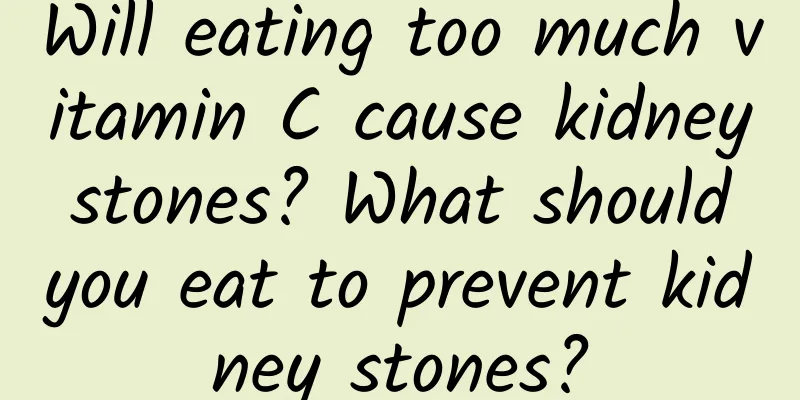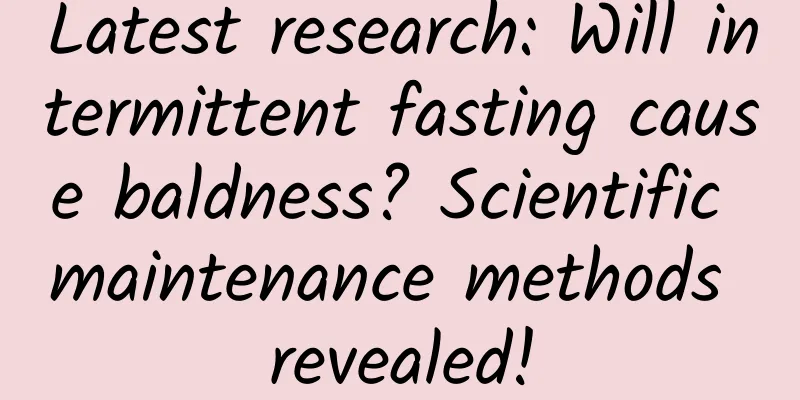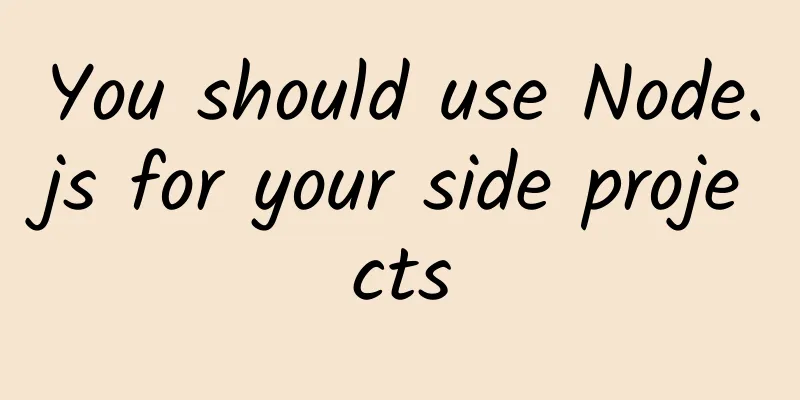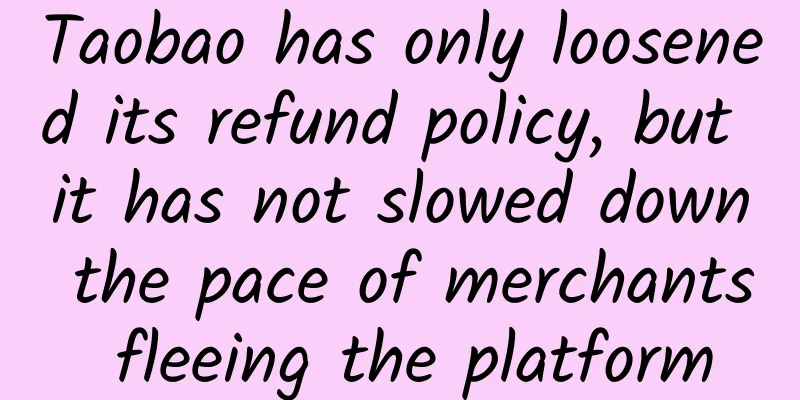Will eating too much vitamin C cause kidney stones? What should you eat to prevent kidney stones?

|
Recently a friend asked me about this. I saw a news report online that drinking vitamin C effervescent tablets can cause kidney stones! Is this true? I am also taking vitamin C. In addition to the vitamin C contained in the multivitamin, I also take two small white VC tablets. Am I at risk of kidney stones... Do I need to stop taking vitamins? One of my colleagues had kidney stones in the summer, and the stone got stuck in his urethra, causing him excruciating pain. We sent him to the hospital, and after listening to the doctor's explanation, we learned what had happened. It left a deep impression on us. He had two more attacks later, and I heard that this disease is prone to recurrence. I said: Don't be nervous. How much vitamin C do you take every day? Tell me the number first. She said: I don't know... Don't criticize me! I am wrong for not reading the label carefully. I said: Since you can criticize yourself and reflect on your mistakes, I will not criticize you. Go and have a look. She said: I looked and found that the vitamin C content in the multivitamin tablets is more than 200 mg, and the small tablets are 100 mg each. The total is more than 400 mg. Is it dangerous? I said: "It's OK, it's not dangerous. Let's talk about whether you can take the pills first, and then talk about vitamin C and kidney stones." Vitamin C itself is an essential nutrient for the body and is safe to take in small amounts. Knowledge point 1: What is the reasonable intake of vitamin C? According to the reference standard of nutrient intake in my country, the reference value of vitamin C intake for healthy adults is 100 mg. Hopefully, this 100 mg is taken from vegetables and fruits, because there are many other plant ingredients taken with VC, which can make VC play a better health role. For example, flavonoids, phenolic acids, anthocyanins, etc. can all help VC. If you are a high-risk group for chronic diseases or anemic people, you can hope to get 200 mg of vitamin C from food. This amount is called the "recommended intake" and is the amount recommended to help prevent disease. It is best to get this amount from fruits and vegetables. If you take part of it from vitamin C pills or health supplements, it is also safe and harmless. If you do have a problem with insufficient vitamin C intake before, or if you need to increase your intake due to some infectious/inflammatory diseases, it is fine to take more than 200 mg of vitamin C in a short period of time, such as 500 mg. My friend was very happy to hear this: Haha, it seems the amount I eat is still safe! However, after taking a large amount of vitamin C, it exceeds the body's reserve capacity, and a large part of the vitamin C will be excreted in the urine and wasted. If you suddenly stop taking the pills, your body is still accustomed to the "waste" mode, which is more likely to cause problems. In short, according to my country's current dietary nutrient intake standards, as long as it is within 2000 mg, it will not cause obvious harm to the vast majority of people. Unless there are some physical conditions that require a lot of vitamin C, such as COVID-19 infection, cold virus infection, etc., I personally do not support taking thousands of milligrams of vitamin C. Under normal circumstances, 100-300 mg is enough to meet nutritional needs and disease prevention needs. One effervescent tablet contains 500 mg or even 1000 mg, which is too much. Not only is it easy to overdose on vitamin C, but you also take in too much sodium, as well as flavors, pigments, sweeteners and other ingredients that have no health benefits. Why bother? Even if you take 1000-2000 mg of vitamin C, some sensitive people, such as those with irritable bowel syndrome and gastrointestinal diseases, may experience some adverse reactions, mainly gastrointestinal discomfort. A large amount of vitamin C that is not absorbed in time will irritate the intestines, which is similar to the principle of abdominal pain and diarrhea caused by eating too much sugar alcohol. A friend asked: So, what is the relationship between vitamin C and kidney stones? Knowledge point 2: Can excessive vitamin C increase the concentration of oxalic acid in urine? After vitamin C is absorbed by the human body and takes effect, part of it will be metabolized into oxalic acid and then excreted in the urine. Because fruits, vegetables, and seeds contain more or less oxalic acid, generally speaking, eating vitamin C normally will not significantly increase the concentration of oxalic acid in the body. For example, the oxalic acid content of spinach can be as high as 0.9%, which is more than 900 mg in 100 grams, but people will not suffer from kidney stones just because they eat spinach occasionally. In comparison, taking one vitamin effervescent tablet containing 500 mg of VC will produce much less oxalic acid than this number, because part of the excess vitamin C is directly excreted in the urine, and another part is excreted in combination with sulfuric acid, and only a small part is degraded into oxalic acid. However, if the amount of vitamin C supplemented is particularly large, such as taking vitamin C effervescent tablets as beverages, drinking cup by cup, several cups a day, then you cannot ignore the issue of increased oxalic acid production. Oxalic acid and trace amounts of calcium exist in urine at the same time. If their total amount is too large or the urine is concentrated and exceeds the solubility of calcium oxalate, it may precipitate and form kidney stones (dissolution-precipitation equilibrium is learned in middle school and also taught in first-year college chemistry courses). My friend said: I understand. After drinking too many effervescent tablets, more oxalic acid is sent to the urine to be excreted. Then the calcium in the urine encounters so much oxalic acid and forms calcium oxalate precipitation. I said: It is possible. However, there are many people who drink effervescent tablets, why don't all of them have kidney stones? She said: Yes, why are only a few people so unlucky? It may be because of their different physical constitutions. I heard that some people are particularly prone to kidney stones, born with this condition. I said: Indeed, in addition to the different amounts of drinking, the risk of kidney stones varies greatly from person to person. There are factors such as genetic predisposition, sweating, drinking enough water, metabolic disorders, excretion capacity, and dietary health. It is very complicated. Knowledge point 3: There are many types of kidney stones. Most of them are stones formed by oxalic acid and calcium, but other substances such as uric acid and phosphoric acid can also form stones with calcium. Many stones are mixed. Therefore, it is necessary to consider other factors besides oxalic acid, especially uric acid. Therefore, in addition to how much oxalic acid and vitamin C are consumed in the diet, we also need to consider how much calcium ions can meet oxalic acid in the urine; we also need to consider what other factors, besides oxalic acid, may affect kidney stones. Knowledge point 4: A diet rich in calcium makes kidney stones less likely to occur. When it comes to the formation of kidney stones, oxalic acid alone cannot make a difference; calcium is also needed. If the concentration of calcium ions in urine is high, then the risk of stone formation will increase at the same oxalic acid content. When a friend heard this, he asked: Is it bad to eat too much calcium-rich food? Would it be safer to eat less calcium? I said: Interestingly, it is the opposite. Many epidemiological studies have confirmed that low dietary calcium intake is not conducive to the prevention of kidney stones. This may be because dietary calcium helps to bind oxalic acid in food in the pot, bowl and gastrointestinal tract, reducing the absorption of oxalic acid and thus reducing the risk of kidney stones. On the other hand, when the body does not take in enough calcium, the blood calcium concentration will not decrease. Because blood calcium is so important, in order to maintain the stability of blood calcium, bone calcium will be decomposed and enter the blood. This will cause fluctuations in blood calcium and increase the risk of kidney stones; on the other hand, it is also easy to cause osteoporosis. Knowledge point 5: Eating too much salt may cause calcium to be excreted into the urine and lost. Chinese people originally consume less calcium in their diet, but they consume more salt. What many people don’t know is that excessive salt intake will promote the excretion of urinary calcium. When urinary calcium increases, more calcium will meet oxalic acid in the urine, and the risk of kidney stones will increase. Therefore, health experts are now advocating salt control. Dietary guidelines recommend controlling daily salt intake to 5 grams (except when sweating a lot). This is not only beneficial for preventing high blood pressure, but also for preventing osteoporosis and kidney stones. When you sweat a lot, some salt is excreted from the sweat, which will certainly reduce the calcium in the urine, but it will also cause the body to be dehydrated and the urine to be concentrated. After being concentrated, it is easier to precipitate. Therefore, you must drink more water in summer, otherwise the risk of kidney stones will increase. Knowledge point 6: Drinking too much beverages will increase uric acid levels and promote kidney stones. Another point of knowledge that many people don’t pay attention to is that drinking sweet drinks can also increase the risk of kidney stones, because one type of kidney stones is uric acid stones. Sweet drinks contain a lot of sucrose (daily white sugar) or fructose syrup. Those sweet drinks with a refreshing taste are mainly syrups with high fructose content. After sucrose is digested in the human body, it will also turn into one molecule of glucose and one molecule of fructose, which is considered half fructose. After a large amount of fructose is absorbed, it will cause the energy substance ATP to convert into AMP in the body, and then be metabolized into the final product uric acid. Knowledge point 7: The ratio of meat to vegetables should be appropriate. Eating too much animal protein will promote calcium loss. Animal protein is rich in sulfur and phosphorus, and excessive intake will increase the acid load and promote the loss of calcium from urine. On the contrary, consuming a lot of potassium and magnesium from plant foods such as fruits and vegetables will help reduce urinary calcium loss, thereby reducing the risk of stones. Of course, insufficient protein is not a good thing either. Insufficient essential amino acids will reduce the absorption and utilization rate of calcium. What is opposed here is the practice of eating meat, fish, seafood, etc. as meals, and eating more meat and less vegetables. It is reasonable to have one serving of meat with 2 to 3 servings of vegetables. Knowledge point 8: Gastrointestinal diseases are not conducive to the prevention of kidney stones. The absorption rate of oxalic acid in food is relatively low after entering the intestines, and most of it will be excreted from the intestines. However, studies have found that once gastrointestinal diseases occur, such as insufficient stomach acid or intestinal leakage, the absorption rate of oxalic acid may increase, causing the concentration of oxalic acid in urine to increase, thereby increasing the risk of kidney stones. In summary, according to current research evidence, people who are at greater risk of kidney stones should take the following dietary measures to prevent them: ——Drink more water. Especially in summer, urine tends to concentrate easily, so make sure you drink enough water. ——Drink less sweet drinks. Reduce fructose intake to avoid raising uric acid levels. ——Don’t eat too much salt (control sodium intake) to avoid calcium being excreted from the urine along with sodium. ——You can eat fish and meat normally, but don’t take them as meals to avoid consuming too much phosphorus, which is not conducive to the utilization of calcium. ——Eating foods rich in calcium, such as dairy products, is beneficial in preventing kidney stones. ——When eating astringent vegetables rich in oxalic acid, it is recommended to blanch them to remove the oxalic acid before eating. ——Eat vegetables and fruits that are not astringent. Most green leafy vegetables do not contain high levels of oxalate. Studies have not found that consuming green leafy vegetables increases the risk of stones. In fact, the DASH diet that advocates eating more vegetables is associated with a lower risk of stones. Green leafy vegetables are rich in magnesium, which helps reduce the risk of kidney stones. -- Try to get vitamin C from food. If you are afraid that it is not enough, you need to take extra supplements. One or two hundred milligrams a day is enough. Unless you have a doctor's order, there is no need to take thousands of milligrams every day. If you like to drink VC effervescent tablets or VC drinks, one cup is enough. It is best not to drink it every day. ——Pay attention to protecting your gastrointestinal function to avoid excessive absorption of oxalic acid due to intestinal dysfunction. My friend said: "You are so patient. You answered three questions at once. I learned eight knowledge points at once. I made a profit." I checked and found that according to my eating habits, the risk of stones is not high. I feel relieved. I said: Actually, there are other knowledge points, but I am afraid that you will not be able to remember them if I say too much at once. That’s all I have to say for now. She said: I will immediately become a setter when I get back and tell my colleagues all this knowledge, hoping that they will not suffer from kidney stones anymore! Reprint/ Cooperation please contact Weibo/ Official Account: Fan Zhihong_Original Nutrition Information |
>>: Dark color vs. light color, which umbrella is more sun-proof?
Recommend
No more breaking up! Russia agrees to extend the operation of the International Space Station
Recently, the Russian State Space Corporation ann...
6 ways to promote brand marketing on Xiaohongshu
Today I want to share with you some little knowle...
Why can't you always catch flies?
Today, we are going to talk about a little creatu...
A cartographic miracle! A 430-year-old hand-drawn giant world map opens your journey through time
Leviathan's note: The world map by Urbano Mon...
Dadong Short Video Local Account Tutorial, including building ideas, layout production, copywriting content, editing operations, etc.
Dadong Short Video Local Account Tutorial, includ...
Xi'an foot bath massage release
Xi'an High-Quality Tea Tasting Selection (WeC...
The gynecological items in the physical examination are so embarrassing, can I not do them?
In the new year, have you done your annual physic...
Samsung should fight Apple instead of Chinese manufacturers
Samsung's Galaxy S6 and Galaxy S6 Edge are in...
What is the mortgage interest rate in July 2020? LPR mortgage interest rate analysis and forecast
China's loan prime rate (LPR) has remained un...
The "weird and beautiful photos of the sky" before the Taiwan earthquake sparked heated discussions! Are there really "earthquake clouds"?
According to official measurements by the China E...
Exhibition optimization case, how to reduce conversion costs by 80%?
This article shares with you a case study of cust...
Google announces a new logo: adapting to multiple platforms. Its expansion ambition is obvious
On September 2, early this morning, Google sudden...
How much does it cost to be an agent of Wuxi Home Improvement Mini Program? What is the price of being an agent for Wuxi home improvement mini program?
Why should you be an agent for WeChat Mini Progra...
Honor Play 7X review: Full screen dual camera + full series 4G RAM to create the ultimate 1,000 yuan flagship
Many people may not have expected that Honor'...
When purchasing heating equipment, look for the 3C mark. What is 3C certification?
Science Fiction Network, December 1 (Xu Mingyang)...









